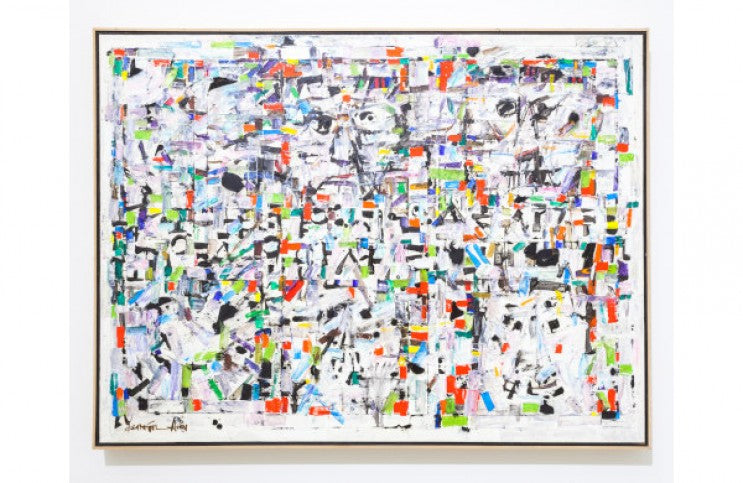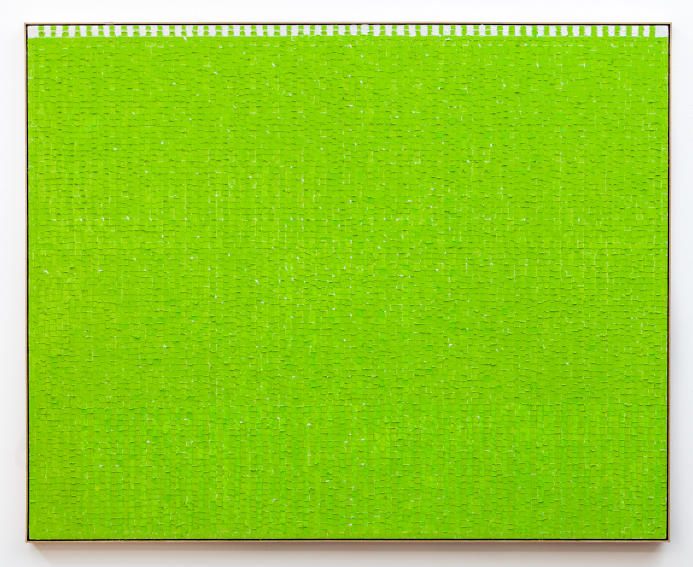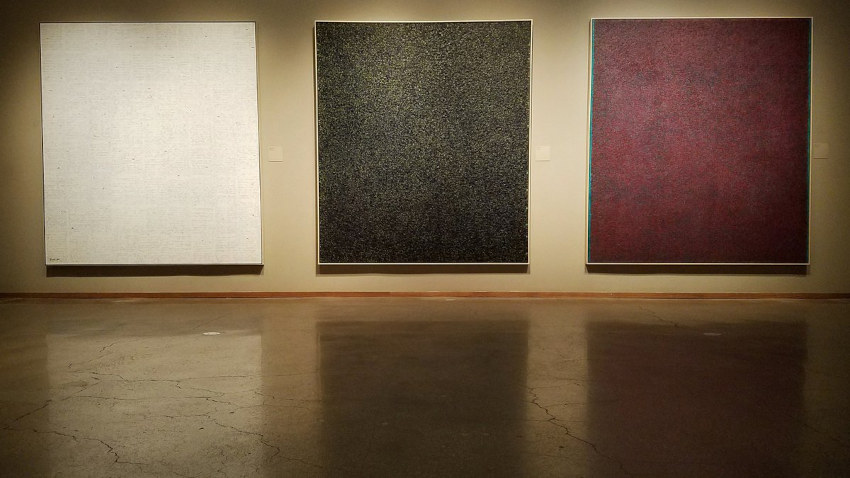
Young-Il Ahn, Korean American Painter of Light and Surface, Dies at 86
Young-Il Ahn, an under appreciated master of abstract painting, whose work explored relationships be-tween color, reflected light, and human perception, died this month in Los Angeles at age 86. Ahn was only just beginning to be recognized by global audiences for his singular painting position, characterized by intricate, colorful, flat marks layered with delicate impasto ridges. Ahn was born in 1934 in Gaesong—today a North Korean city near the demilitarized zone; but then a part of colonial Japan. His father was a painter and art teacher, and his mother was a musician. They began teaching Ahn to paint as soon as he could hold a brush. At six years old he had his first solo exhibition, in a gallery in Tokyo. In 1949, while in middle school, he won the First Korean National Art Exhibition, and then took the Special Prize in the National Art Exhibition the following year, an even higher honor. Yet, despite being hailed as a child prodigy, it was not until 2015 that his talents were celebrated in a solo museum exhibition. Titled A Memoir of Water, that first museum show was not held in his native Korea, but in his adoptive home of Southern California, at the Long Beach Museum of Art. In 2018, Ahn achieved another milestone, shat-tering a glass ceiling by becoming the first ever Korean American painter to receive a solo exhibition at the Los Angeles County Museum of Art (LACMA). How this wunderkind managed to slip from early fame into mid-career obscurity, then be rediscovered in his twilight years is a story full of as many ridges and valleys as one of his signature paintings. As much as it is a story guided by the passions of a single artist, it is also grounded in the enduring forces connecting art, nature, and everyday life.
Light and Surface
Young-Il Ahn first visited America in 1957, when his work was included in an invitational exhibition at the World House Gallery in New York. He visited Chicago in 1959, when he had his first American solo show at Hull House Gallery. When he left Korea for good in 1966, as part of a wave of emigres taking advantage of the US Immigration and Naturalization Act of 1965, which changed immigration policy in the United States to no longer favor Western Europe, it was Los Angeles that he chose to call home. Cu-riously, his arrival in LA happened to coincide with two of the most influential breakthroughs in 20th century art history, both off which occurred in Los Angeles in 1966: James Turrell made his first so-called “aperture” work, and Robert Irwin created his first aluminum disk. Pioneers in the Light and Space Movement, Turrell and Irwin were both born in Southern California, a fact embedded in their ethereal light works, which translate perceptual experiences of light, color, and volume. As soon as Ahn arrived in Los Angeles, he, too, was indelibly affected by the light. Rather than being moved by the relationship be-tween light and space like Turrell and Irwin, however, Ahn became enamored by the interplay of light and color on the surface of the ocean.

Young Il-Ahn, Water YLGG 19, 2019, Oil on canvas, 66 x 82 x 2 in (Courtesy of the Artist and Kavi Gupta, © Young-Il Ahn)
The earliest paintings Ahn made in California were not studies of the ocean, but of adjacent subjects like beach umbrellas, sails and birds. He also painted the musicians whom he counted amongst his few local friends. Semi-abstract and highly expressionistic, those paintings sold well: too well, perhaps. A legal dispute arose between two of his dealers, which stopped Ahn from being able to sell his own work for many years, sending him into a deep depression. Discouraged by the art market, Ahn turned from painting to fishing, often taking long trips by himself in a small boat between Santa Monica and Catalina Island. In his autobiography and still it flows towards me: a life lived with art, Ahn writes, “At these moments, my favorite colors from nature stretched to infinity. The sunlight crashed and reflected against the water every moment, dispersing splendid and sparkling colors in layers.” On one such trip, Ahn became lost in a dense fog. When the fog finally lifted, the sea around him was completely calm. The brilliance of the sunlight shimmering off of the waves in that moment is what inspired him to return to his studio and to create his most well known series—the “Water” series—on which Ahn worked for more than 30 years, until his death.

Young Il-Ahn, Cello Player, 1996, Oil on canvas, 32 x 24 x 2 in (Courtesy of the Artist and Kavi Gupta, © Young-Il Ahn)
Found at Sea
It is not only light and color that Young-Il Ahn expressed in his “Water” paintings. These paintings also express the keen awareness Ahn had of color theory and art history. Innumerable tiny, colored dots pro-vide fleeting moments of Pointillist fascination as the hues merge in the mind to create a monochromatic illusion. Beneath the layers of paint something tragic also lurks, adding a sense of almost physical weight to the work. This could be depth and shadow trying to express itself. It also feels somehow like a glimpse of something lonely in the vastness. As a child, Ahn saw his sister drown in a stream. Lost in the fog dec-ades later, did he fear the same fate? He often said he endeavored to put the “trembling of the universe” into his paintings. The multitude of relationships evident in his “Water” paintings makes them tremble in more ways than one.

Installation photograph, Unexpected Light: Works by Young-Il Ahn, Los Angeles County Museum of Art, February 25, 2017–July 22, 2018, © Young-Il Ahn
In addition to his “Water” paintings and his earlier series, Ahn also created a body of work he referred to as his “Self-Reflection” series. Some of these semi-abstract works examine various personal iconogra-phies, such as fragmented bits of Korean Hongul text; others take stock of the personal feelings of sadness and shock Ahn felt when his adopted nation was attacked by terrorists on September 11th, 2001. When he died, Ahn was in the process of planning an exhibition that would contextualize his “Self-Reflection” se-ries at Kavi Gupta gallery, in Chicago. That exhibition is scheduled to open in late January of 2021. It is a chance for those who are already familiar with Young-Il Ahn to say goodbye to this extraordinary artist, and for those new to his work to become acquainted with a visionary abstract painter whose legacy is just beginning to be understood.
Featured image: Young Il-Ahn, Mask 7-R, 2002, Oil on canvas, 30 x 40 x 2 in (Courtesy of the Artist and Kavi Gupta, © Young-Il Ahn)
All images used for illustrative purposes only
By Phillip Barcio






